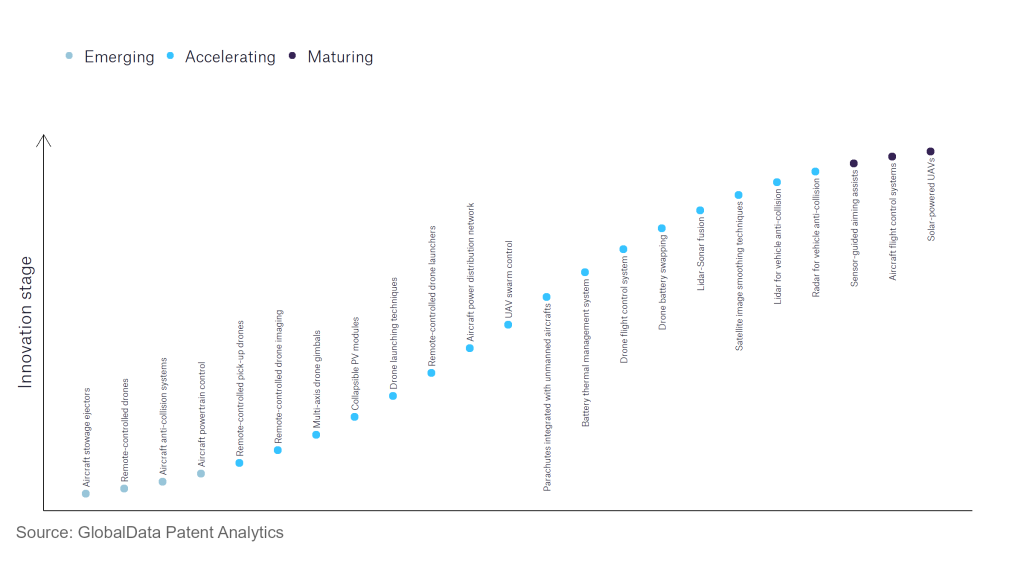The aerospace and defence industry continues to be a hotbed of innovation, with activity driven by the pressing need for modernisation and the growing importance of emerging technologies such as artificial intelligence and unmanned systems. In the last three years alone, there have been over 174,000 patents filed and granted in the aerospace and defence industry, according to GlobalData’s report on Internet of Things in Aerospace, Defence & Security: UAV swarm control. Buy the report here.
However, not all innovations are equal and nor do they follow a constant upward trend. Instead, their evolution takes the form of an S-shaped curve that reflects their typical lifecycle from early emergence to accelerating adoption, before finally stabilising and reaching maturity.
Identifying where a particular innovation is on this journey, especially those that are in the emerging and accelerating stages, is essential for understanding their current level of adoption and the likely future trajectory and impact they will have.
180+ innovations will shape the aerospace and defence industry
According to GlobalData’s Technology Foresights, which plots the S-curve for the aerospace and defence industry using innovation intensity models built on over 262,000 patents, there are 180+ innovation areas that will shape the future of the industry.
Within the emerging innovation stage, aircraft powertrain controls, remote controlled drones, and aircraft anti-collision systems are disruptive technologies that are in the early stages of application and should be tracked closely. UAV swarm control, lidar for vehicle anti-collision, and satellite image smoothing techniques are some of the accelerating innovation areas, where adoption has been steadily increasing.
Innovation S-curve for Internet of Things in the aerospace and defence industry

UAV swarm control is a key innovation area in Internet of Things
UAV swarming capabilities, also referred to as drone swarms, is the concept whereby multiple autonomous or remotely operated unmanned vehicles function as a single cohesive unit, communicating and manoeuvring with each other to achieve the same objective. Controlling UAV swarms thus necessitates critical capabilities in the artificial intelligence, autonomous navigation, sensor/data fusion and remote operation technology domains.
GlobalData’s analysis also uncovers the companies at the forefront of each innovation area and assesses the potential reach and impact of their patenting activity across different applications and geographies. According to GlobalData, there are 20+ companies, spanning technology vendors, established aerospace and defence companies, and up-and-coming start-ups engaged in the development and application of UAV swarm control.
Key players in UAV swarm control – a disruptive innovation in the aerospace and defence industry
‘Application diversity’ measures the number of different applications identified for each relevant patent and broadly splits companies into either ‘niche’ or ‘diversified’ innovators.
‘Geographic reach’ refers to the number of different countries each relevant patent is registered in and reflects the breadth of geographic application intended, ranging from ‘global’ to ‘local’.
Patent volumes related to UAV swarm control
Source: GlobalData Patent Analytics
The leading filer of patents related to UAV swarm control over the last several years has been Intel, as the company has invested heavily in this technology for use in light shows amongst other commercial applications. Tevel Aerobotics Technologies is the second largest patent filer in the UAV swarm control domain, having conducted extensive research and development on this technology for applications in agriculture and other commercial sectors. Boeing has developed UAV swarm control solutions for the defence sector which utilise ScanEagle UAVs and a single operator, however this technology is still in the demonstration phase.
In terms of application diversity, Robotic Research is the largest company, followed by Israel Aerospace Industries and Sony Group in second and third places, respectively. By geographic reach, Tevel Aerobotics Technologies is the top company, followed by Donecle and Israel Aerospace Industries.
Whilst many of the existing patent filings are commercial, the technology has significant military applications and investment by companies including Boeing and Israel Aerospace Industries demonstrates this.
To further understand how Internet of Things is disrupting the aerospace and defence industry, access GlobalData’s latest thematic research report on Thematic Research - Internet of Military Things.
Data Insights
From

The gold standard of business intelligence.
Blending expert knowledge with cutting-edge technology, GlobalData’s unrivalled proprietary data will enable you to decode what’s happening in your market. You can make better informed decisions and gain a future-proof advantage over your competitors.



